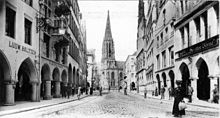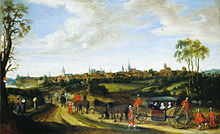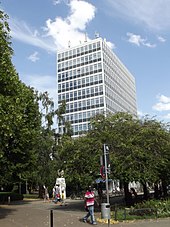
A | B | C | D | E | F | G | H | CH | I | J | K | L | M | N | O | P | Q | R | S | T | U | V | W | X | Y | Z | 0 | 1 | 2 | 3 | 4 | 5 | 6 | 7 | 8 | 9
Münster
Mönster (Westphalian) | |
|---|---|
| Coordinates: 51°57′45″N 07°37′32″E / 51.96250°N 7.62556°E | |
| Country | Germany |
| State | North Rhine-Westphalia |
| Admin. region | Münster |
| District | Urban district |
| Founded | 793 |
| Subdivisions | 6 |
| Government | |
| • Lord mayor (2020–25) | Markus Lewe[1] (CDU) |
| • Governing parties | Greens / SPD / Volt |
| Area | |
| • Total | 302.89 km2 (116.95 sq mi) |
| Elevation | 60 m (200 ft) |
| Population (2022-12-31)[2] | |
| • Total | 320,946 |
| • Density | 1,100/km2 (2,700/sq mi) |
| Time zone | UTC+01:00 (CET) |
| • Summer (DST) | UTC+02:00 (CEST) |
| Postal codes | 48143–48167 |
| Dialling codes | 0251 02501 (Hiltrup, Amelsbüren) 02506 (Wolbeck, Angelmodde) 02533 (Nienberge) 02534 (Roxel) 02536 (Albachten) |
| Vehicle registration | MS |
| Website | www.muenster.de |
Münster (German: [ˈmʏnstɐ] ; Westphalian: Mönster) is an independent city (Kreisfreie Stadt) in North Rhine-Westphalia, Germany. It is in the northern part of the state and is considered to be the cultural centre of the Westphalia region. It is also a state district capital. Münster was the location of the Anabaptist rebellion during the Protestant Reformation and the site of the signing of the Treaty of Westphalia ending the Thirty Years' War in 1648. Today, it is known as the bicycle capital of Germany.[3]
Münster gained the status of a Großstadt (major city) with more than 100,000 inhabitants in 1915.[4] As of 2014[update], there are 300,000[5] people living in the city, with about 61,500 students,[6] only some of whom are recorded in the official population statistics as having their primary residence in Münster. Münster is a part of the international Euregio region with more than 1,000,000 inhabitants (Enschede, Hengelo, Gronau, Osnabrück).
History
Early history
In 793, Charlemagne sent out Ludger as a missionary to evangelise the Münsterland.[7] In 797, Ludger founded a school that later became the Cathedral School.[7] Gymnasium Paulinum traces its history back to this school.[7] Ludger was ordained as the first bishop of Münster.[7] The first cathedral was completed by 850.[7] The combination of ford and crossroad, market place, episcopal administrative centre, library and school, established Münster as an important centre.[8] In 1040, Heinrich III became the first king of Germany to visit Münster.[7]
Middle Ages and early modern period
In the Middle Ages, the Prince-Bishopric of Münster was a leading member of the Hanseatic League.[7]
In 1534, an apocalyptic Anabaptist sect, led by John of Leiden, took power in the Münster rebellion and founded a democratic proto-socialistic state. They claimed all property, burned all books except the Bible, and called it the "New Jerusalem". John of Leiden believed he would lead the elect from Münster to capture the entire world and purify it of evil with the sword in preparation for the Second Coming of Christ and the beginning of the Millennium. They went so far as to require all citizens to be naked as preparation for the Second Coming. However, the town was recaptured in 1535; the Anabaptists were tortured to death and their corpses were exhibited in metal baskets, which can still be seen hanging from the tower of St. Lambert's Church.[7]
Part of the signing of the Peace of Westphalia of 1648 was held in Münster.[9] This ended the Thirty Years' War and the Eighty Years' War.[9] It also guaranteed the future of the prince-bishop and the diocese; the area was to be exclusively Roman Catholic.
18th, 19th and early 20th centuries

The last outstanding palace of the German baroque period, the Schloss Münster, was created according to plans by Johann Conrad Schlaun.[7] The University of Münster (today called "Westfälische Wilhelms-Universität Münster", WWU) was established in 1780. It is now a major European centre for excellence in education and research with large faculties in the arts, humanities, theology, sciences, business and law. Currently there are about 40,000 undergraduate and postgraduate students enrolled.[citation needed] In 1802 Münster was conquered by Prussia during the Napoleonic Wars. It was also part of the Grand Duchy of Berg between 1806 and 1811 and the Lippe department of the First French Empire between 1811 and 1813, before returning to Prussian rule. It became the capital of the Prussian province of Westphalia. In 1899 the city's harbour started operations when the city was linked to the Dortmund-Ems Canal.
World War II

In the 1940s the Bishop of Münster, Cardinal Clemens August Graf von Galen, was one of the most prominent critics of the Nazi government. In retaliation for his success (The New York Times described Bishop von Galen as "the most obstinate opponent of the National Socialist anti-Christian program"[10]), Münster was heavily garrisoned during World War II, and five large complexes of barracks are still a feature of the city. Münster was the headquarters (Hauptsitz) for the 6th Military District (Wehrkreis) of the German Wehrmacht, under the command of Infantry General (General der Infanterie) Gerhard Glokke. Originally made up of Westphalia and the Rhineland, after the Battle of France it was expanded to include the Eupen – Malmedy district of Belgium. The headquarters controlled military operations in Münster, Essen, Düsseldorf, Wuppertal, Bielefeld, Coesfeld, Paderborn, Herford, Minden, Detmold, Lingen, Osnabrück, Recklinghausen, Gelsenkirchen, and Cologne.
Münster was the home station for the VI and XXIII Infantry Corps (Armeekorps), as well as the XXXIII and LVI Panzerkorps. Münster was also the home of the 6th, 16th and 25th Panzer Division; the 16th Panzergrenadier Division; and the 6th, 26th, 69th, 86th, 106th, 126th, 196th, 199th, 211th, 227th, 253rd, 254th, 264th, 306th, 326th, 329th, 336th, 371st, 385th, and 716th Infantry Divisions (Infanterie-division).
A secondary target of the Oil Campaign of World War II, Münster was bombed on 25 October 1944 by 34 diverted B-24 Liberator bombers, during a mission to a nearby primary target, the Scholven/Buer synthetic oil plant at Gelsenkirchen. About 91% of the Old City and 63% of the entire city was destroyed by Allied air raids.[11] The US 17th Airborne Division, employed in a standard infantry role and not in a parachute capacity, attacked Münster with the British 6th Guards Tank Brigade on 2 April 1945 in a ground assault and fought its way into the contested city centre, which was cleared in urban combat on the following day.[12]
Postwar period

From 1946 to 1998, there was a Latvian secondary school in Münster,[13] and in 1947, one of the largest of about 93 Latvian libraries in the West was established in Münster.[14] In the 1950s the Old City was rebuilt to match its pre-war state, though many of the surrounding buildings were replaced with cheaper modern structures. It was also for several decades a garrison town for the British forces stationed in West Germany.
Post-reunification
In 2004, Münster won an honourable distinction: the LivCom-Award for the most livable city in the world with a population between 200,000 and 750,000.[15] Münster is famous and liked for its bicycle friendliness and for the student character of the city that is due to the influence of its university, the Westfälische Wilhelms-Universität Münster.[16][17]
Geography
Geographic position

Münster is situated on the river Aa, approximately 15 kilometres (9 miles) south of its confluence with the Ems in the so-called Westphalian Bight, a landscape studded with dispersed settlements and farms – the "Münsterland". The Wolstonian sediments of the mountain ridge called "Münsterländer Kiessandzug" cross the city from north to south. The highest elevation is the Mühlenberg in the northwest of Münster, 97 metres above sea level. The lowest elevation is at the Ems, 44 m above sea level. The city centre is 60 m above sea level, measured at the Prinzipalmarkt in front of the historic city hall.
The Dutch city of Enschede lies about 65 km (40 mi) northwest of Münster. Other major cities nearby include Osnabrück, about 44 km (27 mi) to the north, Dortmund, about 61 km (38 mi) to the south, and Bielefeld, about 62 km (39 mi) to the east.
Münster is one of the 42 agglomeration areas and one of Germany's biggest cities in terms of area. But it includes substantial sparsely-populated rural districts which were formerly separate local government authorities until they were amalgamated in 1975. Thus nearly half the city's area is agricultural, resulting in a low population-density of approximately 900 inhabitants per km2.


Population density
The city's built-up area is quite extensive. There are no skyscrapers and few high-rise buildings but very many detached houses and mansions. Still the population density reaches about 15,000 inhabitants per km2 in the city centre.[18] Calculating the population density based on the actual populated area results in approximately 2890 inhabitants per km2.[19][verification needed]
Münster's urban area of 302.91 square kilometres (116.95 sq mi) is distributed into 57.54 square kilometres (22.22 sq mi) covered with buildings while 0.99 km2 (0.38 sq mi) are used for maintenance and 25.73 km2 (9.93 sq mi) for traffic areas, 156.61 km2 (60.47 sq mi) for agriculture and recreation, 8.91 km2 (3.44 sq mi) are covered by water, 56.69 km2 (21.89 sq mi) is forested and 6.23 km2 (2.41 sq mi) is used otherwise.[20]: 18 The perimeter has a length of 107 kilometres (66 miles), the largest extend of the urban area in north–south direction is 24.4 km (15.2 mi), in east–west direction 20.6 km (12.8 mi).[21]
Climate
A well-known saying in Münster is "Entweder es regnet oder es läuten die Glocken. Und wenn beides zusammen fällt, dann ist Sonntag" ("Either it rains or the church bells ring. And if both occur at the same time, it's Sunday."), but in reality the rainfall with approximately 758 mm (29.8 inches) per year is close to the average rainfall in Germany.[22] The perception of Münster as a rain-laden city isn't caused by the absolute amount of rainfall but by the above-average number of rainy days with relatively small amounts of rainfall. The average temperature is 9.4 °C (48.9 °F) with approximately 1500 sun hours per year.[22] Consequently, Münster is in the bottom fifth in comparison with other German cities. The winter in Münster is fairly mild and snowfall is unusual. The temperature during summertime meets the average in Germany. The highest daily rainfall was registered on 28 July 2014: One weather station of the MeteoGroup reported a rainfall of 122.2 L/m2 (2.50 imp gal/sq ft); the State Environment Agency registered at one of its stations 292 L/m2 (6.0 imp gal/sq ft) during seven hours.[23] The record rainfall led to severe flooding throughout the city and the nearby Greven.
| Climate data for Münster (Münster Osnabrück Airport) (1991–2020 normals) | |||||||||||||
|---|---|---|---|---|---|---|---|---|---|---|---|---|---|
| Month | Jan | Feb | Mar | Apr | May | Jun | Jul | Aug | Sep | Oct | Nov | Dec | Year |
| Mean daily maximum °C (°F) | 5.2 (41.4) |
6.2 (43.2) |
10.1 (50.2) |
15.0 (59.0) |
18.9 (66.0) |
21.8 (71.2) |
24.2 (75.6) |
23.7 (74.7) |
19.5 (67.1) |
14.5 (58.1) |
9.1 (48.4) |
5.8 (42.4) |
14.5 (58.1) |
| Daily mean °C (°F) | 2.7 (36.9) |
3.1 (37.6) |
5.9 (42.6) |
9.9 (49.8) |
13.7 (56.7) |
16.6 (61.9) |
18.7 (65.7) |
18.3 (64.9) |
14.5 (58.1) |
10.4 (50.7) |
6.3 (43.3) |
3.5 (38.3) |
10.3 (50.5) |
| Mean daily minimum °C (°F) | 0.0 (32.0) |
0.0 (32.0) |
1.9 (35.4) |
4.6 (40.3) |
8.2 (46.8) |
11.2 (52.2) |
13.4 (56.1) |
13.0 (55.4) |
9.9 (49.8) |
6.6 (43.9) |
3.3 (37.9) |
0.9 (33.6) |
6.1 (43.0) |
| Average precipitation mm (inches) | 64.5 (2.54) |
49.2 (1.94) |
49.6 (1.95) |
40.5 (1.59) |
54.8 (2.16) |
63.4 (2.50) |
73.9 (2.91) |
78.5 (3.09) |
68.7 (2.70) |
63.1 (2.48) |
61.5 (2.42) |
67.8 (2.67) |
735.7 (28.96) |
| Average precipitation days (≥ 1.0 mm) | 17.6 | 15.8 | 15.4 | 13.5 | 13.7 | 14.9 | 15.2 | 15.2 | 14.3 | 15.6 | 17.8 | 19.1 | 188.1 |
| Average snowy days (≥ 1.0 cm) | 4.6 | 3.6 | 1 | 0 | 0 | 0 | 0 | 0 | 0 | 0 | 0.5 | 3.3 | 13 |
| Average relative humidity (%) | 85.5 | 82.2 | 76.9 | 69.8 | 69.3 | 71.1 | 71.0 | 73.2 | 79.6 | 83.8 | 87.1 | 87.3 | 78.1 |
| Mean monthly sunshine hours | 51.6 | 73.3 | 124.2 | 178.4 | 206.7 | 203.2 | 212.3 | 193.3 | 148.2 | 108.8 | 57.1 | 44.2 | 1,597.6 |
| Source: World Meteorological Organization[24] | |||||||||||||
Adjacent cities and districts
Münster borders on the following cities and municipalities, named clockwise and beginning in the northwest: Altenberge and Greven (District of Steinfurt), Telgte, Everswinkel, Sendenhorst and Drensteinfurt (District of Warendorf), as well as Ascheberg, Senden and Havixbeck (District of Coesfeld).
City boroughs

The city is divided into six administrative districts or Stadtbezirke: "Mitte" (Middle), "Nord" (North), "Ost" (East), "West", "Süd-Ost" (South-East) and "Hiltrup". Each district is represented by a council of 19 representatives elected in local elections. Heading each council is the district mayor, or Bezirksvorsteher. Every district is subdivided into residential quarters (Wohnbereiche). This official term, however, is not used in common speech, as there are no discrete definitions of the individual quarters. The term "Stadtteil" is used instead, mainly referring to the incorporated communities. The districts are also divided into 45 statistical districts.
The following list names each district with its residential and additional quarters. These are the official names, which partly differ from the usage in common speech.[25]



- Mitte:
- Kernbereich (Centre)
- Nord:
- Münster-Coerde|Coerde
- Kinderhaus
- Sprakel with Sandrup
- Ost:
- West:
- Albachten
- Gievenbeck
- Mecklenbeck
- Nienberge with Häger, Schönebeck and Uhlenbrock
- Roxel with Altenroxel and Oberort
- Sentruper Höhe
- Süd-Ost:
- Angelmodde with Hofkamp
- Gremmendorf with Loddenheide
- Wolbeck
- Hiltrup:
- Amelsbüren with Sudhoff, Loevelingloh and Wilbrenning
- Berg Fidel
- Hiltrup
The centre can be subdivided into historically evolved city districts whose borders are not always strictly defined, such as
- Aaseestadt
- Erphoviertel
- Geistviertel
- Hansaviertel
- Herz-Jesu-Viertel
- Kreuzviertel
- Kuhviertel
- Mauritzviertel
- Neutor
- Pluggendorf
- Rumphorst
- Schlossviertel
- Südviertel
- Uppenberg
- Zentrum Nord
Demographics


| Year | Pop. | ±% |
|---|---|---|
| 1816 | 17,316 | — |
| 1831 | 21,893 | +26.4% |
| 1851 | 25,222 | +15.2% |
| 1871 | 24,821 | −1.6% |
| 1900 | 63,754 | +156.9% |
| 1910 | 90,254 | +41.6% |
| 1919 | 100,452 | +11.3% |
| 1925 | 106,418 | +5.9% |
| 1933 | 122,210 | +14.8% |
| 1939 | 141,059 | +15.4% |
| 1950 | 118,889 | −15.7% |
| 1956 | 155,241 | +30.6% |
| 1961 | 182,721 | +17.7% |
| 1966 | 200,376 | +9.7% |
| 1971 | 198,470 | −1.0% |
| 1976 | 266,083 | +34.1% |
| 1981 | 271,810 | +2.2% |
| 1986 | 246,186 | −9.4% |
| 1991 | 264,181 | +7.3% |
| 1996 | 265,748 | +0.6% |
| 2001 | 267,197 | +0.5% |
| 2006 | 272,106 | +1.8% |
| 2011 | 289,576 | +6.4% |
| 2016 | 311,846 | +7.7% |
| 2021 | 318,293 | +2.1% |
| Population size may be affected by changes in administrative divisions. Source:[26][circular reference] | ||
Münster has a population of about 320,000 people. It is the 10th largest city in North Rhine-Westphalia and the 20th largest city in Germany. It is also the seventh largest German city by area at 303.28 km2 (117.10 sq mi), and serves as the center of the Münster region (known as Münsterland in German). Considered one of the oldest German cities, Münster has been a major city since approximately 1000 AD. It first reached 100,000 inhabitants in 1948, and the population has continued to grow since the 1980s due to the popularity of the local university. Münster is also known for its bicycles, and some estimates suggest it has more bicycles than people. The city reached a population of 300,000 in 2014.[citation needed]
Number of largest foreign groups in Münster by nationality:[27]










